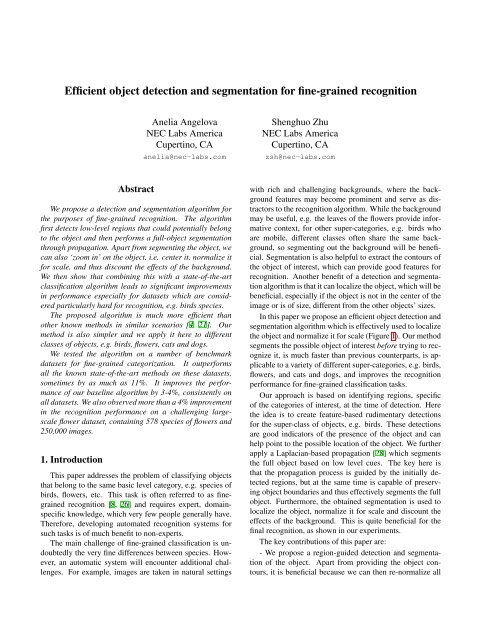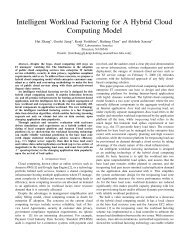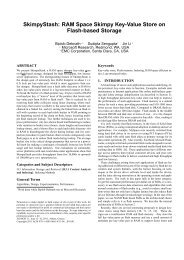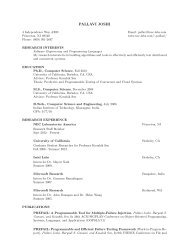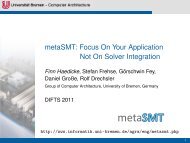Efficient object detection and segmentation for fine-grained recognition
Efficient object detection and segmentation for fine-grained recognition
Efficient object detection and segmentation for fine-grained recognition
Create successful ePaper yourself
Turn your PDF publications into a flip-book with our unique Google optimized e-Paper software.
Figure 4. Example segmented images from the datasets tested in this paper. Although not necessarily perfect, these <strong>segmentation</strong>s aresufficient to remove most of the background. Examples of failed <strong>segmentation</strong>s are shown in the bottom row: only a portion of thebackground is removed, this is typical of flowers since they take larger areas of the image; parts of the <strong>object</strong> are missing, e.g. <strong>for</strong> birds’heads or tails, especially if they are of different colors; finally, some <strong>segmentation</strong>s may completely fail (rightmost pair of images).pooling of the encoded features in the image is done, as wellas, max poolings in a 3x3 grid of the image. Our classificationpipeline uses the 1-vs-all strategy of linear SVM classification<strong>and</strong> we used the Liblinear SVM implementation [7].For the very large 578-flowers dataset, we used a StochasticGradient Descent algorithm, since Liblinear cannot load thewhole data into memory.The segmented image is processed through the same featureextraction pipeline as the original image, that is, newfeatures are extracted <strong>for</strong> the segmented image. We thencombine the two sets of extracted features, by concatenatingtheir feature representations. One thing to note here isthat, because of our decision to apply HOG type features<strong>and</strong> pooling to the segmented image, the <strong>segmentation</strong> helpswith both providing shape of the contour of the <strong>object</strong> to berecognized, as well as, ignoring features in the backgroundthat can be distractors. On the other h<strong>and</strong>, by keeping bothsets of features from the original <strong>and</strong> the segmented image,we can avoid losing precision due to mis-<strong>segmentation</strong>, <strong>and</strong>can also include the background <strong>for</strong> cases <strong>for</strong> which it mayprovide useful context (e.g. the leaves <strong>and</strong> stems of someflowers may be useful <strong>for</strong> <strong>recognition</strong>).In our experiments we found that it is sufficient to keepa global pooling of the segmented image, in addition to thefull set of poolings <strong>for</strong> the original image. We note herethat we re-extract features from the segmented image (withtheir new HOG, encodings etc) <strong>and</strong> since much ‘cleaner’ localfeatures are extracted at the boundary, they provide veryuseful signal, although pooled globally. We believe this iscrucial <strong>for</strong> the improvements we achieved. We cropped theimage to the segmented region (+20 pixels margin), so asto account <strong>for</strong> scale variability. The latter is very beneficialsince these datasets have variabilities in scale <strong>and</strong> oneof the purposes of our <strong>segmentation</strong> is to be able to localizethe <strong>object</strong> <strong>and</strong> normalize <strong>for</strong> its scale. No cropping is done<strong>for</strong> the two flower datasets, since the flowers are assumed totake most of the image area (even <strong>for</strong> small ‘cluster’ flowers).We did not do cropping <strong>for</strong> the experiment which usesground truth bounding box in<strong>for</strong>mation (<strong>for</strong> birds).In terms of computation, our algorithm per<strong>for</strong>ms muchbetter compared to competitors [3, 19]. The <strong>segmentation</strong>takes about 2.5 seconds, <strong>and</strong> our baseline algorithm runswithin 1-2 seconds. We note that the <strong>segmentation</strong> procedureis much faster than previously known <strong>segmentation</strong>methods, which take at least 30 seconds [4, 21]. Furthermore,our <strong>segmentation</strong> run-time allows it to be run as a partof st<strong>and</strong>ard <strong>recognition</strong> pipelines at test time, which had notbeen possible be<strong>for</strong>e, <strong>and</strong> is a significant advantage.
5. ExperimentsIn this section we show experimental results of our proposedalgorithm on a number of <strong>fine</strong>-<strong>grained</strong> <strong>recognition</strong>benchmarks: Ox<strong>for</strong>d 102 flowers [17], Caltech-UCSD 200birds [2, 26], <strong>and</strong> the recent Ox<strong>for</strong>d Cats <strong>and</strong> Dogs [20]datasets. In each case we report the per<strong>for</strong>mance of ourbaseline classification algorithm, the best known benchmarkresults achieved on this dataset, <strong>and</strong> our proposed algorithmin the same settings. We compare to our baselinealgorithm, because it measures how much the proposed <strong>segmentation</strong>has contributed to the improvement in classificationper<strong>for</strong>mance. In addition, we measure our per<strong>for</strong>manceon the large-scale 578-category flower dataset.5.1. Ox<strong>for</strong>d 102 flower species datasetOx<strong>for</strong>d 102 flowers dataset is a well-known dataset <strong>for</strong><strong>fine</strong>-<strong>grained</strong> <strong>recognition</strong> proposed by Nilsback <strong>and</strong> Zisserman[17]. The dataset contains 102 species of flowers <strong>and</strong>a total of 8189 images, each category containing between40 <strong>and</strong> 200 images. It has well established protocols <strong>for</strong>training <strong>and</strong> testing, which we adopt in this paper too.A lot of methods have been tested on this dataset [3, 12,17, 18], including some <strong>segmentation</strong>-based [3, 17]. Someof the <strong>segmentation</strong> methods are designed to be very specificto the appearance of flowers [17] (with the assumptionthat a single flower is in the center of the image <strong>and</strong> takesmost of the image), while others [3] are more general <strong>and</strong>can also be applied to other types of datasets. Our approach,too, does not make assumptions about the set of categories<strong>for</strong> classification or the initial location or size of the <strong>object</strong>sin the image.The per<strong>for</strong>mance of our approach on this dataset (see Table1) is 80.66%, which outper<strong>for</strong>ms all previous knownmethods in the literature (some by as much as 4 to 8%) [3,12, 17, 18]. One important thing to note is that the improvementof our algorithm over our baseline is about 4%, <strong>and</strong>the only difference between the two is the addition of theproposed <strong>segmentation</strong> algorithm <strong>and</strong> the features extractedfrom the segmented image.5.2. Caltech-UCSD 200 birds species datasetCaltech-UCSD-200 Birds dataset [26] is a very challengingdataset containing 200 species of birds. Apart from very<strong>fine</strong>-differences between different species of birds, whatmakes the <strong>recognition</strong> hard in this dataset is the variety ofposes, large variability in scales, <strong>and</strong> also very rich backgroundsin which the birds often blend in. The best classificationper<strong>for</strong>mance achieved on this data is 16.2% classificationrate by [3]. Even when using ground truth boundingboxes, provided as annotations with the dataset [26], the reportedresults have been around 19% [26, 27] <strong>and</strong> most recently24.3% [3], but the latter result additionally uses crudeground truth <strong>segmentation</strong> of each bird.Method Accuracy (in %)Our baseline (no <strong>segmentation</strong>) 76.7Nilsback <strong>and</strong> Zisserman [17] 72.8Ito <strong>and</strong> Cubota [12] 74.8Nilsback <strong>and</strong> Zisserman [18] 76.3Chai, Bicos method [3] 79.4Chai, BicosMT method [3] 80.0Ours 80.66Ours: improvement over our baseline +3.94Table 1. Classification per<strong>for</strong>mance on Ox<strong>for</strong>d 102 flower dataset.The proposed algorithm improves the per<strong>for</strong>mance bothwith <strong>and</strong> without using ground truth bounding boxes (seeTables 2 <strong>and</strong> 3). Our algorithm achieves 30.17% classificationper<strong>for</strong>mance compared to 19.2 [27] in the same setting,which in an improvement of 11% over the best known baselinesin this scenario. Another interesting observation is thatour algorithm achieves a per<strong>for</strong>mance of 27.60% when applying<strong>segmentation</strong> alone (i.e. without combining it withthe baseline algorithm). This is by itself an impressive improvementover the other known algorithms <strong>for</strong> this dataset(even when not taking advantage of our baseline per<strong>for</strong>mance).When considering the benefits of the <strong>segmentation</strong>,we noticed that examples which have more clutteredbackgrounds are helped most by the <strong>segmentation</strong>.Most importantly, our algorithm shows improvementover all known prior approaches, when no ground truthbounding boxes are used. In this case we observed 17.5%classification rate compared to previous 15.7% <strong>and</strong> 16.2%,Our baseline algorithm here achieves only 14.4% whichin on par with the per<strong>for</strong>mance of SPM-type methods inthis scenario. Another thing to notice here is that the improvementover our baseline, when no bounding boxes in<strong>for</strong>mationis known, is larger than the improvement withbounding boxes. This improvement is consistent across theother datasets tested in this paper, which do not have boundingbox in<strong>for</strong>mation. We attribute this to the fact that thebounding boxes have perfect <strong>object</strong> localization <strong>and</strong> scaling,<strong>and</strong> to large extent have background elimination capabilities.This underlines the importance of our proposedautomatic <strong>detection</strong> <strong>and</strong> <strong>segmentation</strong> of the <strong>object</strong>, whichthen allows to ‘zoom in’ on the <strong>object</strong>, especially <strong>for</strong> largescaledatasets <strong>for</strong> which providing bounding boxes or otherground truth in<strong>for</strong>mation will be infeasible.5.3. Ox<strong>for</strong>d Cats <strong>and</strong> Dogs datasetOx<strong>for</strong>d Cats <strong>and</strong> Dogs [20] is a new dataset <strong>for</strong><strong>fine</strong>-<strong>grained</strong> classification which contains 6033 images of37 breeds of cats <strong>and</strong> dogs. Parkhi et al, who collectedthe dataset, showed impressive per<strong>for</strong>mance on thisdataset [20]. They apply <strong>segmentation</strong> at test time, as isdone here, but their algorithm is based on Grabcut [21],
Method Accuracy (in %)Our baseline (no <strong>segmentation</strong>) 14.4Chai, Bicos <strong>segmentation</strong> [3] 15.7Chai, BicosMT <strong>segmentation</strong> [3] 16.2Ours 17.5Ours, improvement over our baseline +3.1Table 2. Classification per<strong>for</strong>mance on Caltech-UCSD 200 birdsdataset with automatic <strong>segmentation</strong>. Please refer to Table 3 <strong>for</strong>comparison to other baselines which additionally use ground truthbounding box in<strong>for</strong>mation.Method (with ground truth boxes) Accuracy (in %)Our baseline (no <strong>segmentation</strong>) 29.06Branson et al [2] 19.00Yao et al. [27] 19.20Chai et al. [3] 23.30Ours, <strong>segmentation</strong> only, see text 27.60Ours 30.17Ours, improvement over our baseline +1.11Table 3. Classification per<strong>for</strong>mance on Caltech-UCSD 200 birdsdataset, when ground truth bounding boxes are used (the resultin [3] uses crude ground truth <strong>segmentation</strong> masks in addition tobounding boxes).which is slow. Also, the methods proposed in [20] are specificto recognizing cat <strong>and</strong> dog breeds <strong>and</strong> utilize head <strong>and</strong>body layout in<strong>for</strong>mation.We compared our per<strong>for</strong>mance on this dataset with theprespecified protocol proposed in the paper (Table 4). Forthis dataset too, we see that our general method outper<strong>for</strong>msthe best category-specific one from [20] <strong>and</strong> is far betterthan their more general approach (denoted as ‘image infoonly’) or a bag of words-based method. Note that [20] alsoreported classification when using cat <strong>and</strong> dog head annotationsor ground truth <strong>segmentation</strong> during testing, whereashere our experiments do not use such in<strong>for</strong>mation.5.4. Large-scale 578 flower species datasetThis dataset consists of 578 species of flowers <strong>and</strong> containsabout 250,000 images <strong>and</strong> is the largest <strong>and</strong> most challengingsuch dataset we are aware of. The goal of developingthis data is to build a <strong>recognition</strong> application which canrecognize <strong>and</strong>/or provide top K suggestions (e.g., <strong>for</strong> K=5,10, etc.) <strong>for</strong> an input flower image, <strong>and</strong> be available <strong>for</strong>general use.We tested our baseline algorithm vs the proposed<strong>segmentation</strong>-based algorithm on this data, see Table 5.The improvement provided by our <strong>segmentation</strong> method is4.41% <strong>for</strong> the top 1 returned result. Figure 5 shows the<strong>recognition</strong> per<strong>for</strong>mance <strong>for</strong> top K, where K = 1, . . . , 10.As seen, we obtain improvements across all of them, withMethod Accuracy (in %)Our baseline (no <strong>segmentation</strong>) 50.79VLFeat [24] + Bag of words [20] 38.45Parkhi et al. (image info only) [20] 39.64Parkhi et al. [20] 54.05Ours 54.30Ours, improvement over our baseline +3.51Table 4. Classification per<strong>for</strong>mance on Ox<strong>for</strong>d Cats <strong>and</strong> Dogsdataset.Method Accuracy (in %)Our baseline (no <strong>segmentation</strong>) 52.35Ours 56.76Ours, improvement over our baseline +4.41Table 5. Classification per<strong>for</strong>mance on the large-scale 578 flowersdataset <strong>for</strong> the top returned result.top 1 having an improvement of about 4.41%, top 5 of about2.7% <strong>and</strong> top 10 of about 2%.Note that this large-scale data has no <strong>segmentation</strong>ground truth or bounding box in<strong>for</strong>mation (since it contains250,000+ images <strong>and</strong> obtaining those would be prohibitiveor at least very expensive). Thus, here the advantage that anautomatic <strong>segmentation</strong> algorithm can give in terms of improvingthe final classification per<strong>for</strong>mance is really important.Another interesting fact is that here we have used thesame initial region <strong>detection</strong> model that was trained on theOx<strong>for</strong>d 102 flowers dataset, which contains fewer speciesof flowers (102 instead of 578). This was motivated againby the lack of good ground truth <strong>for</strong> such a large volume ofdata. Naturally, the per<strong>for</strong>mance of the <strong>segmentation</strong> algorithmcan be further improved after adapting the <strong>segmentation</strong>model to this specific dataset.Discussion. As seen by the improvements over the baseline,our <strong>segmentation</strong> algorithm gives advantage in <strong>recognition</strong>per<strong>for</strong>mance. This is true even if the <strong>segmentation</strong>may be imperfect <strong>for</strong> some examples. This shows that segmentingout the <strong>object</strong> of interest during testing is of crucialimportance <strong>for</strong> an automatic algorithms <strong>and</strong> that it is worthwhileexploring even better <strong>segmentation</strong> algorithms.6. Conclusions <strong>and</strong> future workWe propose an algorithm which combines region-based<strong>detection</strong> of the <strong>object</strong> of interest <strong>and</strong> full-<strong>object</strong> <strong>segmentation</strong>through propagation. The <strong>segmentation</strong> is applied attest time <strong>and</strong> is shown to be very useful <strong>for</strong> improving theclassification per<strong>for</strong>mance on four challenging datasets.We tested our approach on the most contemporary <strong>and</strong>challenging datasets <strong>for</strong> <strong>fine</strong>-<strong>grained</strong> <strong>recognition</strong> improvedthe per<strong>for</strong>mances on all of them. We further tested with
Classification rate0.90.850.80.750.70.650.60.550.5BaselineSegmentation1 2 3 4 5 6 7 8 9 10Top KFigure 5. Classification per<strong>for</strong>mance on the large-scale 578 flowersdataset <strong>for</strong> top K = 1, . . . , 10 retrieved results.578-category flower dataset which is the largest collectionof flower species we are aware of. The improvements in per<strong>for</strong>manceover the baseline are about 3-4%, which is consistentacross all the experiments. Our algorithm is muchfaster than previously used <strong>segmentation</strong> algorithms in similarscenarios, e.g. [4, 21]. It is also applicable to a variety oftypes of categories, as shown in this paper on birds, flowers,<strong>and</strong> cats <strong>and</strong> dogs.Our future work will consider improvements to the featuremodel, e.g. represent it as a mixture of submodels, eachone responsible <strong>for</strong> a subset of classes that are very similarto each other but different as a group from the rest.AcknowledgementsWe thank the team at the Department of Plant <strong>and</strong> Microbial Biologyat UC Berkeley, lead by Prof. Chelsea Specht. The collectionof the large-scale 578-class flower dataset would not havebeen possible without their critical expertise in flower identification.We also thank Dr. Yuanqing Lin <strong>and</strong> Olga Russakovsky <strong>for</strong>their help <strong>and</strong> <strong>for</strong> valuable discussions.References[1] B. Alexe, T. Deselaers, <strong>and</strong> V. Ferrari. Classcut <strong>for</strong> unsupervisedclass <strong>segmentation</strong>. ECCV, 2010.[2] S. Branson, C. Wah, B. Babenko, F. Schroff, P. Welinder,P. Perona, <strong>and</strong> S. Belongie. Visual <strong>recognition</strong> with humansin the loop. ECCV, 2010.[3] Y. Chai, V. Lempitsky, <strong>and</strong> A. Zisserman. Bicos: A bi-levelco-<strong>segmentation</strong> method <strong>for</strong> image classification. ICCV,2011.[4] G. Csurka <strong>and</strong> F. Perronnin. An efficient approach to semantic<strong>segmentation</strong>. IJCV, 2011.[5] Q. Dai <strong>and</strong> D. Hoiem. Learning to localize detected <strong>object</strong>s.CVPR, 2012.[6] N. Dalal <strong>and</strong> B. Triggs. Histograms of oriented gradients <strong>for</strong>human <strong>detection</strong>. CVPR, 2005.[7] R.-E. Fan, K.-W. Chang, C.-J. Hsieh, X.-R. Wang, <strong>and</strong> C.-J. Lin. Liblinear: A library <strong>for</strong> large linear classification.Journal of Machine Learning Research, 2008.[8] R. Farrell, O. Oza, N. Zhang, V. Morariu, T. Darrell, <strong>and</strong>L. Davis. Birdlets: Subordinate categorization using volumetricprimitives <strong>and</strong> pose-normalized appearance. ICCV,2011.[9] P. Felzenszwalb <strong>and</strong> D. Huttenlocher. <strong>Efficient</strong> graph-basedimage <strong>segmentation</strong>. IJCV, 2004.[10] C. Gu, J. Lim, P. Arbelaez, <strong>and</strong> J. Malik. Recognition usingregions. CVPR, 2011.[11] D. Hoiem, A. Efros, <strong>and</strong> M. Hebert. Closing the loop onscene interpretation. CVPR, 2008.[12] S. Ito <strong>and</strong> S. Kubota. Object classfication using heterogeneousco-occurrence features. ECCV, 2010.[13] A. Joulin, F. Bach, <strong>and</strong> J. Ponce. Discriminative clustering<strong>for</strong> image co-<strong>segmentation</strong>. CVPR, 2010.[14] F. Khan, J. van de Weijer, <strong>and</strong> M. Vanrell. Top-down colorattention <strong>for</strong> <strong>object</strong> <strong>recognition</strong>. ICCV, 2009.[15] N. Kumar, P. Belhumeur, A. Biswas, D. Jacobs, J. Kress,I. Lopez, <strong>and</strong> J. Soares. Leafsnap: A computer vision system<strong>for</strong> automatic plant species identification. ECCV, 2012.[16] Y. Lin, F. Lv, S. Zhu, M. Yang, T. Cour, K. Yu, L. Cao, <strong>and</strong>T. Huang. Large-scale image classification: fast feature extraction<strong>and</strong> svm training. CVPR, 2011.[17] M.-E. Nilsback <strong>and</strong> A. Zisserman. Automated flower classificationover a large number of classes. ICVGIP, 2008.[18] M.-E. Nilsback <strong>and</strong> A. Zisserman. An automatic visual flora- <strong>segmentation</strong> <strong>and</strong> classification of flower images. DPhilThesis, University of Ox<strong>for</strong>d, UK, 2009.[19] O. Parkhi, A. Vedaldi, C. V. Jawahar, <strong>and</strong> A. Zisserman. Thetruth about cats <strong>and</strong> dogs. ICCV, 2011.[20] O. Parkhi, A. Vedaldi, C. V. Jawahar, <strong>and</strong> A. Zisserman. Cats<strong>and</strong> dogs. CVPR, 2012.[21] C. Rother, V. Kolmogorov, <strong>and</strong> A. Blake. Grabcut: Interactive<strong>for</strong>eground extraction using iterated graph cuts. ACMTrans. Graphics, 2004.[22] O. Russakovsky, Y. Lin, K. Yu, <strong>and</strong> L. Fei-Fei. Objectcentricspatial pooling <strong>for</strong> image classification. ECCV, 2012.[23] J. Sanchez, F. Perronnin, <strong>and</strong> T. de Campos. Modeling thespatial layout of images beyond spatial pyramids. PatternRecognition Letters, 2012.[24] A. Vedaldi <strong>and</strong> B. Fulkerson. Vlfeat library.[25] J. Wang, J. Yang, K. Yu, F. Lv, T. Huang, <strong>and</strong> Y. Gong.Locality-constrained linear coding <strong>for</strong> image classification.CVPR, 2010.[26] P. Welinder, S. Branson, T. Mita, C. Wah, F. Schroff, S. Belongie,<strong>and</strong> P. Perona. Caltech-ucsd birds 200. Technical ReportCNS-TR-2010-001, Cali<strong>for</strong>nia Institute of Technology,2010.[27] B. Yao, A. Khosla, <strong>and</strong> L. Fei-Fei. Combining r<strong>and</strong>omization<strong>and</strong> discrimination <strong>for</strong> <strong>fine</strong> <strong>grained</strong> image categorization.CVPR, 2011.[28] D. Zhou, O. Bousquet, T. Lal, J. Weston, <strong>and</strong> B. Scholkopf.Learning with local <strong>and</strong> global consistency. NIPS, 2004.


